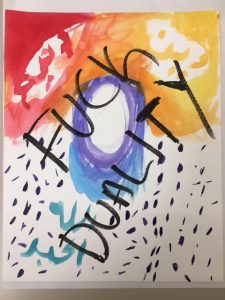Apr
25

While painting this, I was thinking about binaries and how often they are used in discourse surrounding Muslim women. For instance, the uncovered woman is liberated and brave while the veiled Muslim woman is oppressed and voiceless. In the article “Unveiling Scheherazade”, Charlotte Weber highlights that Western feminists buy into the sexualized, harem image of women in Muslim countries. For instance, in Jane Eyre, the Orientalist imagery links the root of patriarchy to Eastern culture. Similarly, in Western movies, niqabis and the backdrop of Arab countries is used to set the scene of a backwards, simple culture. It creates a another duality between Western and Muslim women and assumes Muslim women cannot have “progressive” ideals.
The link of national identity to the hijab also sets up a binary in the Islamic world because those Muslim women who choose to not wear the veil are seen as Westernized and thus as supporting imperialism. It also employs a misreading of history where it is believed that this new and more conservative practice of Islam has been practiced in East for centuries. It posits the West against the East as well, as if the two are completely incompatible.
The duality I chose to highlight in this piece is that between deen and dunya. On one side of the picture, it says deen in Arabic. The other side says dunya. I often feel like, with every action, I am choosing between my religion and the present world. However, I have grown to believe that the practice of religion, deen, does not include completely forgoing the dunya. It is impossible, for me at least, to always act “Islamically”- human weakness is natural. However, this does not mean I would ever stop practicing Islam because I cannot be a perfect Muslim. In other words, I believe one’s relationship with Islam spectrum rather than duality.